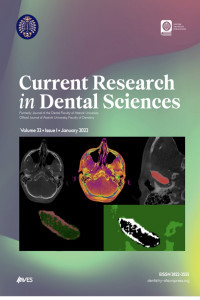DİJİTAL PANORAMİK GÖRÜNTÜLERDE UZAMIŞ STİLOİD PROSES PREVALANSI VE STİLOİD PROSES UZUNLUĞUNUN YAŞ VE CİNSİYETLERE GÖRE DEĞERLENDİRİLMESİ
Stiloid proses, Eagle sendromu, temporal kemik
___
- 1. Roopashri G, Vaishali M, David MP, Baig M, Shankar U. Evaluation of elongated styloid process on digital panoramic radiographs. J Contemp Dent Pract 2012;13:618-22.
- 2. Alpoz E, Akar GC, Celik S, Govsa F, Lomcali G. Prevalence and pattern of stylohyoid chain complex patterns detected by panoramic radiographs among Turkish population. Surgical and Radiologic Anatomy 2014;36:39-46.
- 3. Okabe S, Morimoto Y, Ansai T, et al. Clinical significance and variation of the advanced calcified stylohyoid complex detected by panoramic radiographs among 80-year-old subjects. Dentomaxillofacial Radiology 2006;35:191-9.
- 4. Eagle WW. Elongated styloid process: further observations and a new syndrome. Archives of otolaryngology 1948;47:630-40.
- 5. Watanabe P, Dias F, Issa J, Monteiro S, de Paula F, Tiossi R. Elongated styloid process and atheroma in panoramic radiography and its relationship with systemic osteoporosis and osteopenia. Osteoporosis international 2010;21:831-6.
- 6. Sudhakara Reddy R, Sai Kiran C, Sai Madhavi N, Raghavendra M, Satish A. Prevalence of elongation and calcification patterns of elongated styloid process in south India. J Clin Exp Dent 2013;5:e30-5.
- 7. Lins CCdSA, Tavares RMC, Silva CCd. Use of digital panoramic radiographs in the study of styloid process elongation. Anatomy Res Int 2015;2015: 474615.
- 8. Bagga MB, Kumar CA, Yeluri G. Clinicoradiologic evaluation of styloid process calcification. Imaging Sci Dent 2012; 42: 155-61.
- 9. Öztunç H, Evlice B, Tatli U, Evlice A. Cone-beam computed tomographic evaluation of styloid process: a retrospective study of 208 patients with orofacial pain. Head & Face Med 2014;10:5.
- 10. Chabikuli N, Noffke C. Styloid process elongation according to age and gender: a radiological study. South African Dent J 2016;71:470-3.
- 11. Vieira EMM, Guedes OA, De Morais S, De Musis CR, De Albuquerque PAA, Borges ÁH. Prevalence of elongated styloid process in a central brazilian population. Journal of clinical and diagnostic research: JCDR 2015;9:ZC90-2.
- 12. Guimarães A, Cury S, Silva M, Junqueira J, Torres S. Prevalence of elongated styloid process and/or ossified stylohyoid ligament in panoramic radiographs. Revista Gaúcha de Odontologia 2010; 58:481-5.
- 13. Valerio CS, Peyneau PD, de Sousa ACPR, et al. Stylohyoid syndrome: surgical approach. Journal of Craniofacial Surgery 2012;23:e138-40.
- 14. İlgüy M, İlgüy D, Güler N, Bayirli G. Incidence of the type and calcification patterns in patients with elongated styloid process. J Int Med Res 2005; 33:96-102.
- 15. Kursoglu P, Unalan F, Erdem T. Radiological evaluation of the styloid process in young adults resident in Turkey's Yeditepe University faculty of dentistry. Oral Surgery, Oral Medicine, Oral Pathology, Oral Radiology, and Endodontology 2005;100:491-4.
- 16. Rath G, Anand C. Abnormal styloid process in a human skull. Surgical and Radiologic Anatomy 1991;13:227-9.
- 17. More CB, Asrani MK. Evaluation of the styloid process on digital panoramic radiographs. Indian Journal of Radiology and Imaging 2010;20:261-5.
- 18. de Oliveira Pinto PR, da Luz Vieira G, de Menezes LM, Rizzatto SMD, Brücker MR. Evaluation of the styloid process in subjects with class III malocclusion. Revista Odonto Ciência 2008;23:44-7.
- 19. Tavares H, Freitas C. Prevalence of the elongated styloid process of temporal bone and calcification of the stylohyoid ligament by panoramic radiography. Revista de Odontologia da Universidade da Cidade de Sao Paulo 2007;19:188-200.
- 20. Jung T, Tschernitschek H, Hippen H, Schneider B, Borchers L. Elongated styloid process: when is it really elongated? Dentomax Radiol 2004;33:119-24.
- 21. De Paula M, Carraretto F. Prevalence of elongation of the styloid process in patients with temporomandibular disorders. Revista da Imagem. 2008;30:1-5.
- 22. Natsis K, Repousi E, Noussios G, Papathanasiou E, Apostolidis S, Piagkou M. The styloid process in a Greek population: an anatomical study with clinical implications. Anatomical Sci Int 2015;90:67-74.
- 23. Shaik MA, Naheeda N, Sultan K, Abdul W, Shahul H. Prevalence of elongated styloid process in Saudi population of Aseer region. Eur J Dent 2013;7:449-54.
- 24. Keur J, Campbell J, McCarthy J, Ralph W. The clinical significance of the elongated styloid process. Oral Surg Oral Med Oral Pathol 1986;61:399-404.
- 25. MacDonald-Jankowski D. Calcification of the stylohyoid complex in Londoners and Hong Kong Chinese. Dentomaxillofac Radiol 2001;30:35-9.
- 26. Nalçacı R, Mısırlıoğlu M. Yaşlı bireylerde stiloid proçesin radyolojik olarak değerlendirilmesi. Atatürk Üniv Diş Hek Fak Derg 2006;16:1-6.
- 27. Sokler K, Sandev S. New classification of the styloid process length–clinical application on the biological base. Collegium Antropolog 2001; 25: 627-32.
- 28. Anbiaee N, Javadzadeh A. Elongated styloid process: is it a pathologic condition? Indian J Dent Res 2011;22:673-7.
- 29. Gokce C, Sisman Y, Ertas ET, Akgunlu F, Ozturk A. Prevalence of styloid process elongation on panoramic radiography in the Turkey population from cappadocia region. Eur J Dent 2008;2:18-22.
- Başlangıç: 1986
- Yayıncı: Atatürk Üniversitesi
THE EFFECT OF QMix SOLUTION IN THE REMOVAL OF CALCIUM HYDROXIDE FROM ARTIFICIALLY CREATED GROOVES
Ertuğrul KARATAŞ, Hakan ARSLAN, Ahmet Demirhan UYGUN, Eyüp Candaş GÜNDOĞDU
EVALUATION OF STRESS DISTRIBUTION OF DIFFERENT RESTORATIVE MATERIALS IN CLASS V CAVITIES
REHABILITATION OF MAXILLECTOMY CASE WİTH CONVENTIONAL RETAINED OBTURATOR PROSTHESIS: A CASE REPORT
MANDİBULAR GÖMÜLÜ 3.MOLAR CERRAHİ ÇEKİM SONRASI KOMPLİKASYONLAR VE EL TERCİHİ ARASINDAKİ İLİŞKİ
Utkan Kamil AKYOL, Neziha KEÇECİOĞLU
Emre KORKUT, Murat S. BOTSALI, Yağmur ŞENER
Melda MISIRLIOĞLU, Mehmet Zahit ADIŞEN, Kubilay BARIŞ
MANAGEMENT OF TOOTH EXTRUSION AS A COMPLICATION DUE TO INTERMAXILLARY FIXATION: TWO CASE REPORTS
